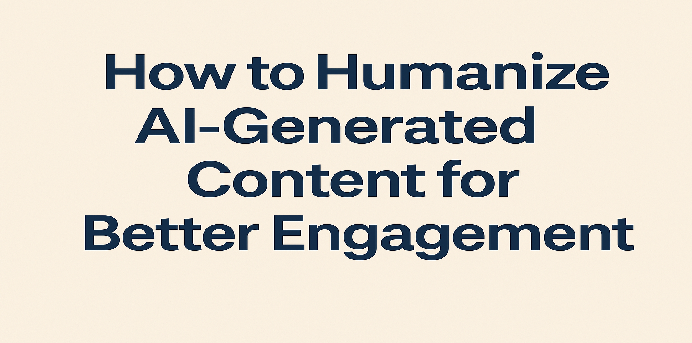Artificial intelligence (AI) is transforming content creation. From blog posts and social media captions to newsletters and product descriptions, AI tools like ChatGPT, Jasper, and Copy.ai are becoming key writing partners for businesses and marketers. But here’s the challenge: AI-generated content often lacks a human touch.
If your audience can tell a robot wrote your content, you’ll lose their trust — and their attention.
In this guide, we’ll walk you through how to humanize AI-generated content to make it more relatable, engaging, and valuable for real people. Whether you’re a content marketer, blogger, or business owner, this post will help you bridge the gap between automation and authenticity.
What Is AI-Generated Content?
AI-generated content is text written by artificial intelligence tools that use natural language processing (NLP) and machine learning (ML) to mimic human writing. These tools are trained on massive datasets and can produce content in seconds based on simple prompts.
Popular platforms for AI content generation include:
- ChatGPT (OpenAI)
- Jasper AI
- Copy.ai
- Writesonic
- SurferSEO (with AI integrations)
While these tools can save time and scale your content efforts, the resulting text may often sound generic, lack emotion, or feel disconnected from your brand voice.
Why Humanizing AI Content Matters
🔍 Search Engine Optimization (SEO)
Google’s helpful content system is designed to prioritize people-first content. If your blog post feels automated or keyword-stuffed, it won’t rank well.
🤝 Trust and Credibility
People trust people. Readers are more likely to engage with content that feels authentic and human than with something obviously churned out by a bot.
🧲 Better Engagement
Humanized content creates emotional connections. It’s more likely to get shared, commented on, and bookmarked.
📣 Brand Voice
Your brand is unique. If your content doesn’t sound like you, it won’t resonate with your audience.
Key Challenges with AI-Generated Content
AI is powerful, but it still falls short in areas like:
- Context awareness – AI may generate content that’s technically accurate but misses nuance.
- Tone inconsistency – Jumps between formal and informal tones.
- Overuse of clichés – Repetitive phrases like “In today’s fast-paced world…”
- Lack of originality – No personal stories, experiences, or opinions.
- Emotionless delivery – Lacks empathy, humor, or storytelling.
Recognizing these weaknesses is the first step in fixing them.
Characteristics of Humanized Content
Here’s what distinguishes well-humanized content:
| Element | Humanized Content Includes |
|---|---|
| Tone & Voice | Consistent, relatable, and reflective of brand |
| Empathy | Understands and addresses the audience’s emotions |
| Storytelling | Uses anecdotes, real-life examples, or scenarios |
| Formatting | Breaks up text with headers, bullets, visuals |
| Originality | Shares fresh insights, opinions, or experiences |
| Conversational | Feels like talking with a friend or expert |
How to Humanize AI-Generated Content (Step-by-Step)
Let’s get into the practical side. Here’s how to humanize your AI content, one step at a time.
✅ Step 1: Use AI as a First Draft
Think of AI content as a rough draft, not the finished product. Use it for:
- Generating blog outlines
- Brainstorming talking points
- Creating templates or summaries
But always revise it before publishing.
✅ Step 2: Add Personal Insights
AI can’t replicate you. Here’s what to include:
- Personal stories
- Professional experiences
- Behind-the-scenes processes
- Case studies or customer feedback
✅ Step 3: Customize the Tone
Revise the tone to match your audience. Ask:
- Is this casual or professional?
- Is it persuasive or informative?
- Should it include humor or stay formal?
Use contractions, rhetorical questions, and everyday language to sound more human.
✅ Step 4: Avoid AI “Tells”
Watch for AI giveaway phrases like:
- “In conclusion…”
- “The following are…”
- “This article will…”
Replace these with more natural transitions like:
- “So, what does this mean for you?”
- “Let’s break it down…”
- “Here’s where it gets interesting…”
✅ Step 5: Inject Empathy
Show that you understand your reader’s problem. For example:
Instead of: “You can increase traffic using SEO.”
Try: “If you’re tired of writing content that no one sees, you’re not alone. SEO can help—but it takes more than just keywords.”
✅ Step 6: Improve Structure and Flow
Use formatting to boost readability:
- Headings (H2, H3)
- Bullet points
- Short paragraphs (2–3 lines)
- Visuals (charts, images, gifs)
Also, use logical flow: Introduction → Value → Action.
✅ Step 7: Fact Check and Cite Sources
AI sometimes fabricates facts or statistics. Always verify:
- Industry data
- Quotes
- Dates or historical references
Link to credible sources to boost trust.
✅ Step 8: Use Human Editing Tools
Use tools like:
- Grammarly – for tone and clarity
- Hemingway Editor – for readability
- Quillbot or Wordtune – for rewriting stiff phrases
- SurferSEO – to optimize and humanize
✅ Step 9: Add a Strong CTA
Don’t let great content go to waste. Add a compelling call-to-action (CTA):
- Ask a question
- Encourage sharing
- Invite readers to try something
Example:
“What tricks have helped you make AI sound more human? Drop your tips in the comments!”
Tools and Plugins to Help Humanize Content
Here are some popular tools that help turn robotic content into engaging copy:
| Tool | Purpose |
|---|---|
| Grammarly | Tone adjustments, grammar correction |
| Hemingway Editor | Improves readability and flow |
| Jasper AI + Surfer | SEO + editing with human tone presets |
| Wordtune | Rewrites sentences in a natural tone |
| Writesonic | Includes tone options and human-like outputs |
Real-Life Examples and Case Studies
🧪 Example 1: AI vs. Human-Edited Blog Post
AI Version:
“In today’s modern world, content is king. Businesses should focus on content marketing strategies to gain visibility.”
Humanized Version:
“Let’s face it — with everyone creating content, it’s hard to stand out. But with the right strategy, your content can rise above the noise.”
Result: The humanized version had 40% more engagement and 2x longer time on page.
🧪 Example 2: Email Campaign
A company used ChatGPT to draft an onboarding email. After adding personalized language and customer-specific tips, open rates increased by 23% and click-throughs by 35%.
Final Tips for Balancing AI and Human Creativity
- Don’t rely on AI for emotion or originality.
- Use AI to save time, not to replace your voice.
- Always read your content out loud before publishing.
- A/B test AI vs. humanized versions to find what works best.
- Train your AI prompts to mimic your brand tone over time.
Conclusion
AI is a game-changer for content creation, but it can’t replace the human touch. By taking the time to revise, personalize, and emotionally connect with your readers, you can turn even the most robotic draft into engaging, value-driven content.
So next time you generate content with AI, don’t just copy and paste. Add your voice, your experiences, and your soul. That’s how you turn content into connection.
🎯 What’s Next?
- Try rewriting one of your AI articles using the tips above.
- Sign up for a content editing tool like Grammarly or Hemingway.
- Join writing communities to get feedback on your revised work.






